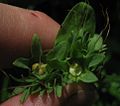Mertensia virginica
| Virginia bluebells | |
|---|---|

| |
| Scientific classification | |
| Kingdom: | Plantae |
| Clade: | Tracheophytes |
| Clade: | Angiosperms |
| Clade: | Eudicots |
| Clade: | Asterids |
| Order: | Boraginales |
| Family: | Boraginaceae |
| Genus: | Mertensia |
| Species: | M. virginica
|
| Binomial name | |
| Mertensia virginica | |
Mertensia virginica (common names Virginia bluebells,[1] Virginia cowslip,[2] lungwort oysterleaf, Roanoke bells) is a spring ephemeral plant in the Boraginaceae (borage) family with bell-shaped sky-blue flowers, native to eastern North America.
Description
[edit]Virginia bluebells have rounded (ovate) and gray-green leaves, borne on stems up to 24 in (60 cm) tall. The leaves are up to 5 in (13 cm) long, smooth (entire) along their margins, petiolate at the bottom of the flower stem, and sessile at the top.[3]
The inflorescence is a nodding group, or cyme of flowers located at the end of the arched stems.[3] The flower buds are pink, and the opened flowers are usually light blue, but occasionally pink and rarely white.[2] The flowers have 5 shallow lobes fused into a tube at the base of the flower, five stamens, and a central pistil (carpel).[3]
Distribution and habitat
[edit]M. virginica is native in the United States from Kansas in the west, to Mississippi, Alabama, and Georgia in the south, and to Maine in the northeast. It is native in Canada in Ontario and Quebec.[4] The plant can be found in rich, moist woods and on low, wooded hillsides. They often form large groups.[2]
Ecology
[edit]The plant develops very early in the spring and flowers mid-spring. In early summer, each fertilized flower produces four seeds within wrinkled nuts. The plant then goes dormant till the next spring.[3]
The flowers attract long-tongued bees, such as bumblebees, butterflies, moths, skippers, hummingbird moths, flower flies, bee flies, and hummingbirds.[5]
Uses
[edit]Virginia bluebells had several uses in traditional Native American medicine, including as a pulmonary aid, tuberculosis treatment, and treatment for whooping cough (Cherokee,) root infusion antidote for treating poison, and root decoction venereal to treat venereal issues (Iroquois.).[6] Native Americans believed a tonic made from this plant could help heal those who were under-the-weather.
Mertensia virginica is edible, including the flowers.[7]
In cultivation, M. virginica has gained the Royal Horticultural Society's Award of Garden Merit.[8]
- Photos
-
Virginia Bluebells (Mertensia virginica) in Ohio
-
Leaves before blooming
-
Flower buds
-
A pink-flowered form
-
A white-flowered form
-
Fruits
-
Woods carpeted in bluebells
-
A bumblebee hanging from a bluebell
Nomenclature
[edit]Mertensia virginica is the type species for the genus Mertensia and was first described by Linnaeus in 1753 as Pulmonaria virginica.[9] The genus Pulmonaria is today restricted to 19 species in the tribe Boragineae. When Albrecht Wilhelm Roth erected the genus Mertensia in 1797, he named the Virginia bluebell as Mertensia pulmonarioides, apparently unaware that Linnaeus had already named it in his Species Plantarum. Roth's name is a superfluous synonym and has been used in recent literature.[10]
References
[edit]- ^ NRCS. "Mertensia virginica". PLANTS Database. United States Department of Agriculture (USDA). Retrieved 28 January 2016.
- ^ a b c Denison, Edgar (2017). Missouri Wildflowers. Conservation Commission of the State of Missouri. p. 80. ISBN 978-1-887247-59-7.
- ^ a b c d "Virginia Bluebells (Mertensia virginica)". www.illinoiswildflowers.info.
- ^ "NatureServe Explorer 2.0". explorer.natureserve.org.
- ^ "Virginia Bluebells, Mertensia virginica". Wisconsin Horticulture.
- ^ "BRIT - Native American Ethnobotany Database". naeb.brit.org. Retrieved 2022-03-10.
- ^ "Virginia Bluebells". Forager Chef. 2021-04-17. Retrieved 2022-03-10.
- ^ "AGM Plants - Ornamental" (PDF). Royal Horticultural Society. July 2017. p. 64. Retrieved 4 April 2018.
- ^ Carl von Linné (Linnaeus). 1753. Species Plantarum 1:135. (see External links below)
- ^ James S. Pringle. 2004. "Nomenclature of the Virginia-bluebell, Mertensia virginica (Boraginaceae)". SIDA, contributions to botany 21(2):771-775.(see External links below)
External links
[edit]- Wildflower.org: Native Plant Identification Network
- Missouri Plants: Mertensia virginica
- Illinois Plant Information Network: Mertensia virginica
- RHS Plant Selector: Mertensia virginica
- Pulmonaria In Species Plantarum vol. 1 At Botanicus
- Nomenclature of the Virginia bluebell At Volume 21, View Book At SIDA, contributions to botany At BHL
- Mertensia virginica in the CalPhotos photo database, University of California, Berkeley









